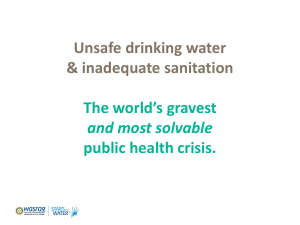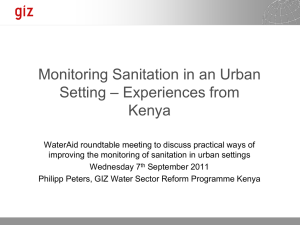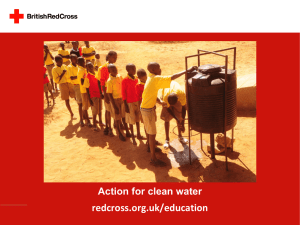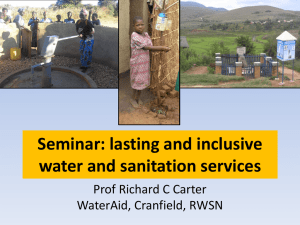3. Adequate Access, Coverage & Technical Standards (Part II)
advertisement
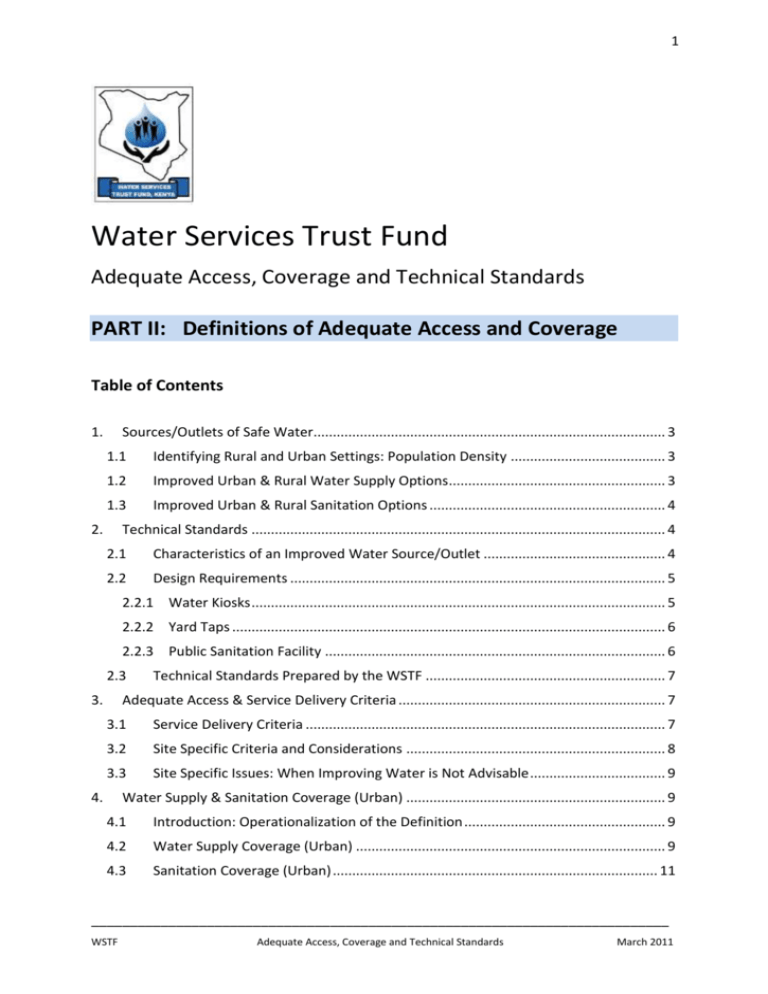
1 Water Services Trust Fund Adequate Access, Coverage and Technical Standards PART II: Definitions of Adequate Access and Coverage Table of Contents 1. Sources/Outlets of Safe Water........................................................................................... 3 1.1 Identifying Rural and Urban Settings: Population Density ........................................ 3 1.2 Improved Urban & Rural Water Supply Options........................................................ 3 1.3 Improved Urban & Rural Sanitation Options ............................................................. 4 2. Technical Standards ........................................................................................................... 4 2.1 Characteristics of an Improved Water Source/Outlet ............................................... 4 2.2 Design Requirements ................................................................................................. 5 2.2.1 Water Kiosks ........................................................................................................... 5 2.2.2 Yard Taps ................................................................................................................ 6 2.2.3 Public Sanitation Facility ........................................................................................ 6 2.3 3. Technical Standards Prepared by the WSTF .............................................................. 7 Adequate Access & Service Delivery Criteria ..................................................................... 7 3.1 Service Delivery Criteria ............................................................................................. 7 3.2 Site Specific Criteria and Considerations ................................................................... 8 3.3 Site Specific Issues: When Improving Water is Not Advisable ................................... 9 4. Water Supply & Sanitation Coverage (Urban) ................................................................... 9 4.1 Introduction: Operationalization of the Definition .................................................... 9 4.2 Water Supply Coverage (Urban) ................................................................................ 9 4.3 Sanitation Coverage (Urban) .................................................................................... 11 ___________________________________________________________________________ WSTF Adequate Access, Coverage and Technical Standards March 2011 2 4.3.1 Household and Plot-Level Sanitation Facilities .................................................... 11 4.3.2 Public Sanitation (Facilities) ................................................................................. 11 4.3.3 Sludge Management ............................................................................................ 12 List of Abbreviations ................................................................................................................. 12 Appendices ............................................................................................................................... 13 Appendix1: Technical Standards (WSTF) ............................ Error! Bookmark not defined. Appendix 2: Kiosk Calculation Sheet ................................... Error! Bookmark not defined. ___________________________________________________________________________ WSTF Adequate Access, Coverage and Technical Standards March 2011 3 Adequate Access, Coverage and Technical Standards Discussion Paper PART II: Definitions of Adequate Access and Coverage 1. Sources/Outlets of Safe Water 1.1 Identifying Rural and Urban Settings: Population Density An area is considered to be an urban setting if the local population density exceeds 400 persons per km2. However, local conditions in rural settings – e.g. the water table, soil conditions, frequent flooding and uneven distribution of the population resulting in high population densities in micro settings – may render some water supply and sanitation options (e.g. hand pumps, protected yard wells, improved pit latrines) to be unsuitable. In these settings the urban list of improved options has to be adopted. 1.2 Improved Urban & Rural Water Supply Options The following water supply options are considered to be improved water sources or outlets: Improved facility (water supply) Type of water source/outlet WASREB (X = improved facility) JMP Urban areas Rural areas All areas X X X X X X X Public tap/standpipe, water provided by licensed ISP or community groups X X Tubewell/borehole X X Protected dug well X X Protected spring X X Rainwater collection X X Piped water into dwelling, plot or yard supplied by licensed WSPs (1) Piped water into dwelling, plot or yard supplied by ISP or Cat. 2 WSPs (2) Public tap/standpipe, water provided by licensed WSPs (1) (3) X Unprotected dug well Unprotected spring Cart with small tank/drum Tanker truck Bottled water 1 Surface water (river, dam, lake, pond, stream, canal, irrigation channels) 1): Category I WSPs only; 2): Including the water kiosk; 3): Including the prepaid public stand post. 1 Bottled water is considered to be improved by JMP only when the household uses water from an improved source for cooking and personal hygiene. ___________________________________________________________________________ WSTF Adequate Access, Coverage and Technical Standards March 2011 4 1.3 Improved Urban & Rural Sanitation Options The following sanitation options are considered to be improved sanitation facilities: Type of sanitation facility/practice Improved facility (sanitation) WASREB (X = improved facility) Urban areas JMP Rural areas All areas Flush or pour flush to piped sewer system (not shared) X (4) X X Flush or pour flush to septic tank (not shared) X X X Flush or pour flush to pit latrine (not shared) X X X Flush or pour-flush to piped sewer system (plot-level, shared by max. 10 persons) X X Flush or pour flush to septic tank (plot-level, shared by max. 10 persons) X X Flush or pour flush to pit latrine (plot-level, shared by max. 10 persons) X X Public sanitation facility Ventilated improved pit latrine (VIP) X X X X X Pit latrine with slab X X X X X X (1) Composting toilet Flush of pour flush to elsewhere (2) Pit latrine without slab Bucket Hanging toilet or hanging latrine No facility or use of bush or field (3) 1): Only an improved sanitation facility in certain urban settings such as urban slums with very high population densities (See also Part I; section 6.6.1). 2): E.g. excreta are flushed to the street, yard or plot, open sewer, a ditch, a drainage way or other location 3): In rural areas with very low population densities open defecation or “cat system” defecation may not pose a risk to public health and to the environment. 4): The fact that a sanitation facility is improved does not imply that the sludge, excreta and/or compost are managed in a sustainable and environmentally- and public health-friendly manner. 2. Technical Standards 2.1 Characteristics of an Improved Water Source/Outlet An improved water or sanitation source or facility should: Minimise health risks (e.g. allow for the safe delivery and use of safe water, hygienically separate human excreta from human contact). Be accessible and user-friendly. Provide security to its users. Reflect the needs and wishes (including of its customers, operators and owners) and consider cultural and religious factors. Not have a negative impact upon the environment. The next sections present the main design requirements of: ___________________________________________________________________________ WSTF Adequate Access, Coverage and Technical Standards March 2011 5 2.2 Water kiosks. Yard taps. Public sanitation facilities. Design Requirements 2.2.1 Water Kiosks A water kiosk which can be categorised as an improved water source should meet the following main design requirements: Elevated fetching bay. It helps to bring the water container near the taps which facilitates water fetching, which can be kept clean and reduces the risk of water contamination. Drainage gloves. They helps to drain waste water away to soak away pit or to the drainage channels hence reduces the chances of water contamination. Wide bay window. A bay window helps to protect the taps from theft and vandalism. Also it gives the operator a good view when serving the customer to avoid water spring off the container, and facilitate communication between the kiosk operator and the customer. Reinforced concrete columns. The columns help to carry the load from the overhead water tanks to avoid the structure from collapsing. Plumbing works. Plumbing work should be of good quality to avoid leakages and contamination. Accessible fetching pillars which facilitate the lifting of 20-litre containers (on the head or back). Steel door. It should be strong enough to avoid thieves from breaking in the kiosk. Picture 1: A prefabricated water kiosk in Athi River Picture 2: An insitu water kiosk in Athi River ___________________________________________________________________________ WSTF Adequate Access, Coverage and Technical Standards March 2011 6 2.2.2 Yard Taps A yard tap which can be categorised as an improved water source should meet the following design main requirements: Water tap. It should be of good quality to avoid regular maintenance. Water taps should be at a reasonable height to avoid water from spring off (when the tap is too height) or being knocked by the mouth of container during lifting. (when the tap is too low) Yard tap pillar. It should be of strong material (reinforced concrete pillar or steel stanchion) to prevent the up stand pipe from vandalism. Elevated fetching platform. It helps to drain waste water away and also prevent the storm water getting in the platform during the rainy seasons. This reduces the chances of water contamination. Pictures 3 & 4: Yard taps in Nakuru 2.2.3 Public Sanitation Facility A public sanitation facility which can be categorised as an improved sanitation facility should meet the following main design requirements: Wide entry. The entry should be wide enough to avoid congestion and collision of the users when getting in and out of the facility. Spacious corridors and lobbies. This improves circulation inside the facility hence avoiding congestions hence allowing free flow of the customers Well ventilated. A public sanitation facility should be well ventilated to allow fresh air inside the facility. This keeps dad smell off the facility. Lighting. The facility should have wide opening to allow enough light to penetrate inside. This helps the use to see where he/she is walking through. ___________________________________________________________________________ WSTF Adequate Access, Coverage and Technical Standards March 2011 7 Strong structural components. It is essential to have strong structural components (columns, beams and slabs) to carry roof and water tanks loads to the ground. Use of good quality and appropriate materials. It reduces the cost of maintenance. They also facilitate the cleaning of the facility and reduce chances of accidents inside the facility i.e. sliding (if floor tiles are smooth) etc. Position of the operator. The operator room should be position in a way that he/she can monitor all the activities happening inside and the outside of the facility. Easy access for disabled persons and small children. Easy access for emptying services (bowsers) and required maintenance and repair works. Pictures 5 & 6: Public sanitation facility (PSF) in Athi River 2.3 Technical Standards Prepared by the WSTF Appendix 1 contains the technical drawings and bills of quantities of the improved: Water kiosks (open and closed). Yard tap. Public sanitation facility. 3. Adequate Access & Service Delivery Criteria 3.1 Service Delivery Criteria When defining adequate access the following service delivery criteria should be considered: Number of persons per facility and daily quantities/person consumed. Location, distance and accessibility (e.g. no need to cross a dangerous road, etc.) of the infrastructure. Waiting time (at the facility). ___________________________________________________________________________ WSTF Adequate Access, Coverage and Technical Standards March 2011 8 Business hours (access hours). Water quality. Quantity of water available (pressure & supply hours). Tariff. Technical standards (no. of taps, user-friendliness, security, ability to keep the facility clean, etc.). Technical conditions of the facility Security of access (technical standards) . Quality of the service & customer care (provided by the WSP and the Operator) Environmental impact. The following table shows the criteria (1-8) that can be included in a national definition of adequate access. The remaining criteria (9-14) are also important but are area/site specific and, therefore, have to be used during the planning phase and during monitoring by the WSP. No. Criterion Unit 1 Persons/facility 2 Part of national definition of adequate access? Mandate /responsible organisation Remarks No. Yes WASREB Distance Metres Yes WASREB 3 Water quality G/F/P (*) Yes WASREB 4 Water pressure Litres/min. Yes WASREB 5 Supply hours Hours/day Yes WASREB 6 Business hours Hours/day Yes WASREB 7 Tariff KSh/22 litres Yes WASREB Approved by WASREB 8 Technical standard .. Yes WASREB Approved (WASREB & KBS) WSTF designs 9 Technical condition G/F/P No WASREB Monitoring of infrastructure 10 Hygienic condition G/F/P No WASREB Monitoring of infrastructure 11 Environmental impact .. No WSP/NEMA 12 Location & accessibility G/F/P No WSP Local assessment 13 Waiting time Minutes No WSP Data collected with customer survey 14 Quality of service G/F/P No WSP/Operator Data collected with customer survey Monitored by WASREB/WHO standards Local assessment/planning phase *): G = Good; F = Fair; P = Poor 3.2 Site Specific Criteria and Considerations The hygienic condition, for example, has to be assessed by the WSP, considering such factors as cleanliness at the time of the visit, number of times the kiosk is cleaned, drainage, solid waste near the kiosk, problems caused by water and rainwater. The accessibility of a water kiosk or public sanitation facility is also determined by the local topography. A kiosk may only be 500 metres away from a dwelling but if women are forced to walk uphill with a heavy container…. ___________________________________________________________________________ WSTF Adequate Access, Coverage and Technical Standards March 2011 9 A high water table may render a specific site unsuitable, from a public health and environmental for the construction of a water kiosk. Crime levels and the harassment of women, but also a busy and dangerous road may also prevent adequate access to available water supply and sanitation facilities. The importance of area and site specific conditions highlights the importance of paying sufficient attention to the selection of sites for WSS infrastructure. This means giving sufficient attention to the public health, social, financial/commercial, technical, legal (availability of land, etc.) and environmental challenges and objectives of the WSS project or scheme. 3.3 Site Specific Issues: When Improving Water is Not Advisable Improving water supply and sanitation in urban low income areas is important. However, there are more - related- public health risks such as high population densities, poor drainage and the absence of a solid wastage collection/management system. In other words, when addressing public health we have to adopt a more holistic approach by considering other environmental factors. In low income areas with a high water table or areas frequently exposed to flooding, the improvement of the water supply situation alone will not necessarily result in an improved public health situation. In fact, the improved water supply situation could attract more people to an area which population, if the settlements cannot be made habitable by improving drainage, should be resettled. 4. Water Supply & Sanitation Coverage (Urban) 4.1 Introduction: Operationalization of the Definition A definition of adequate access has to meet the following objectives: The definition should allow for the achievement of the service standards and objectives set by the sector. The definition should be applicable country-wide. Compliance or non-compliance with the access criteria has to be measurable. The definition should allow for the preparation of a definition (formula) of coverage which can be used to calculate coverage figures at area, WSP, WSB and national level. Coverage means sustainable access to safe water and adequate sanitation. 4.2 Water Supply Coverage (Urban) Assuming: the distance between the dwellings and the public or communal water outlet (e.g. kiosk) does not exceed 500 metres (walking distance), ___________________________________________________________________________ WSTF Adequate Access, Coverage and Technical Standards March 2011 10 water is supplied by a licensed WSP [i.e. a Provider with a valid Service Provision Agreement (SPA)], water quality is monitored and measured according to the frequency2 required by the Regulator and if it meets the standards set by WASREB, the water pressure measured at the tap is at least 17 litres per minute, the area is supplied at least 6 days/week, the kiosk is supplied and open to customers (business hours) at least 6 hours/day, the tariff is pro-poor and approved by the Regulator, the water outlet/facility meets the technical standards set by the sector (see Appendix 1), then the following number of persons can be said to have adequate access to safe water supplied by the following water supply outlets/facilities: Type of connection Additional characteristics No. of Persons adequately served Remarks 1 Individual connection Indoor plumbing 10 This is the estimated number of people using a domestic connection 2 Plot-level connection Yard tap (one tap) 30 Figure based on average plot population size 3 Public stand post Equipped with 1 tap 400 Improved public stand posts only 4 Prepaid public stand post Equipped with 1 tap 400 Improved prepaid public stand posts only 5 Water kiosk (closed or open) Equipped with 3 taps 1,200 6 Non-domestic connection Irrelevant 0 Assuming a consumption of 8l/c/d A commercial or institutional connection (etc.) If, considering water kiosks only: water pressure at the tap is 15 litres per minute, a kiosk is equipped with 3 taps and a full 20-litre container contains 22 litres of water. If we assume the following: 45 litres of water/minute can be supplied by the kiosk which amounts to 123 full 20-litre containers/hour (approximately 2,706 litres). Water wastage is 3% (= 81 litres/hour), which means 2,625 litres of water/hour can be fetched at the kiosk (= 119 full 20-litre containers = 2 containers per minute). The time required to place and remove containers on the fetching bay is 10 seconds/container. This means that approximately 90 containers/hour can be fetched at the kiosk (= 1,980 litres). Daily per capita consumption is 8 litres. There are no peak demand hours. If a kiosk is to adequately serve 1,200 residents, then: 248 persons can be served/hour. The kiosk needs to be open at least 4.8 hours/day to serve 1,200 customers (residents). 2 E.g. the number of samples per parameter in the network for an annual water production of < 240,000 m 3: bacteriological 12/year, residual chlorine 48/year) (WASREB 2008: 14) ___________________________________________________________________________ WSTF Adequate Access, Coverage and Technical Standards March 2011 11 Appendix 2 contains a sheet which can be used to calculate the impact of pressure and per daily capita consumption on the number of residents that can be served/hour and the number of hours a water kiosk has to remain open. 4.3 Sanitation Coverage (Urban) 4.3.1 Household and Plot-Level Sanitation Facilities One (1) improved (see section 1.3) household or plot-level sanitation unit (door) can adequately provide sanitation access to 10 persons provided they are living on the same plot (within the same yard or compound) or on the same floor (in case of a block of flats). 4.3.2 Public Sanitation (Facilities) Assuming: population density is such that the construction of dwelling or plot level sanitation is not feasible. the distance between the dwellings and the public sanitation facility or communal water outlet (e.g. kiosk) does not exceed 500 metres (walking distance), water is supplied by a licensed WSP [i.e. a Provider with a valid Service Provision Agreement (SPA)], the duration of a man’s short call (including entering the facility, hand washing, paying and leaving the facility) is 5 minutes, and only a urinal is used, the duration of a man’s long call (including entering the facility, hand washing, paying and leaving the facility) is 10 minutes. the duration of a woman’s short & long call (including entering the facility, hand washing, paying and leaving the facility) is 12 minutes. the duration of a disabled person’s visit to the toilet facility is 15 minutes, the toilet is open and operational (i.e. sufficient water of good quality is available) for at least 8 hours. then the following types of toilet can adequately serve: Public sanitation facility Short call Long call Type of toilet: Persons/hour Persons/hour Men’s urinal 12 - Women’s toilet 5 5 Men’s toilet - 6 Disabled persons toilet 4 4 If we accept the above-mentioned assumptions, a public sanitation facility which is equipped with 3 urinals, 2 men’s toilets 3 women’s toilets and one toilet for the disabled can adequately serve (36 + 15 + 12 + 4) 67 persons/hour and 536 persons (customers) per day. ___________________________________________________________________________ WSTF Adequate Access, Coverage and Technical Standards March 2011 12 4.3.3 Sludge Management When considering the environmental and public health objectives of (improved) sanitation, the entire sanitation chain has to be analysed. In other words, a public sanitation facility can only be considered an improved facility if such activities as emptying, transport, disposal and sludge treatment do not cause harm to the environment and to public health. List of Abbreviations JMP: Joint Monitoring Programme l/c/d: Litres per capita per day MWI: Ministry of Water and Irrigation NEMA: National Environmental Management Authority SPA: Service Provision Agreement UfW: Unaccounted for water UNICEF: United Nations Children’s Fund WASREB: Water Services Regulatory Board WHO: World Health Organisation WSB: Water Services Board WSP: Water Service Provider WSTF: Water Services Trust Fund __________________________________ ___________________________________________________________________________ WSTF Adequate Access, Coverage and Technical Standards March 2011 13 Appendices ___________________________________________________________________________ WSTF Adequate Access, Coverage and Technical Standards March 2011




